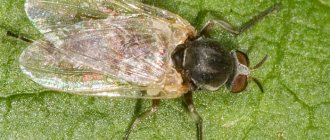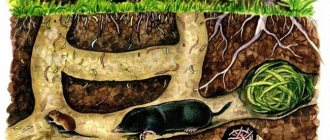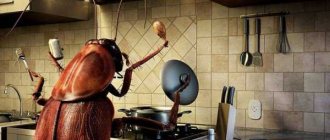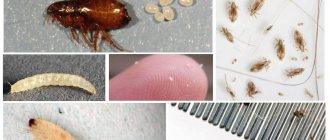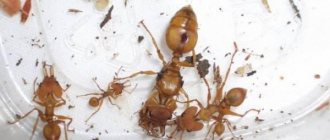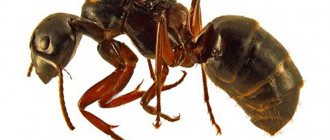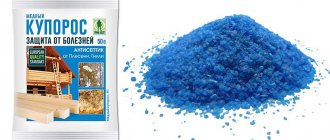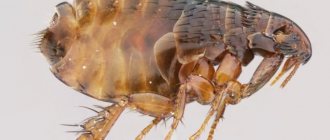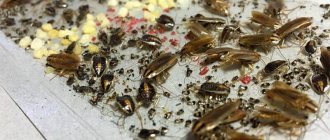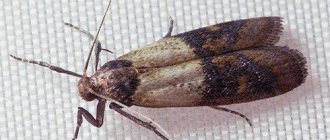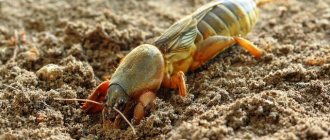Grinder beetles are insects from the order Coleoptera. The group is polymorphic, so it is difficult to find characteristics for all members of the family, but the general description is still the same for all.
The beetles are small in size, ranging from 1 to 10 millimeters; the most common are individuals 5 mm long. Their antennae are comb-shaped, consisting of several segments. The legs of the larvae are very developed, having claws with two scutes.
Beetles are found everywhere, the most common being the furniture borer, house borer and bread borer. Popularly, these insects are called woodborers, woodborers and woodborers, and the last of the woodborers is safe, but significantly harms supplies of other materials and food.
All beetles develop according to the same pattern and go through four stages. Females lay eggs in holes and crevices of dead wood. Then the larvae appear, they bite into the wood, eating out long, winding passages in it. Before the larvae transform into pupae, they move closer to the surface, the insect flies out and it is not the borer beetle that causes harm, but its larvae themselves. The larvae look like small worms, the body is white, and the head is dark brown.
The period of maturation of larvae from eggs is one to two weeks. They have very hard jaws; the larvae literally burrow into the wood. That part of the wood that has not had time to digest is thrown out; it represents drill flour, which clogs the passages. Larvae develop over a long period of time - from 12 months to several years. In some cases, this may be due to the rather late detection of this pest in a wooden house. Three weeks pass after pupation, and the cycle ends with the appearance of the beetle. This usually happens in early summer.
Grinders are ubiquitous. They destroy almost all deciduous and coniferous wood. Some of them make a sound similar to the ticking of a clock; this occurs during the mating period, when they hit their heads against the walls of the passage.
Types of unwanted neighbors
Insects of the Grinder family are varied in their preferences. Some cause serious damage to food supplies, others to medicinal raw materials. Yet pests that specialize in wood, from furniture to walls, roofs and stairs, are especially dangerous. The following types of insects can cause problems in Russia:
- Furniture sharpener. The most common beetle is 2.7-4.5 mm long, brown-brown in color. Adult males make a recognizable "ticking" sound, which in some countries has been nicknamed the "death clock". The damage is caused not by adult insects (which do not live long), but by the larvae. They are the ones who happily absorb wood and leave behind channels in furniture, floors, and window frames.
Development cycle of a furniture grinder Source zaggo.ru
- House grinder. An adult insect, 3.8-7 mm long, is colored in shades of brown, from almost black to reddish. The larvae develop in deciduous and coniferous wood, often choosing areas already affected by house fungus. The house borer beetle can be found in any wooden structure, in ceiling beams, baseboards, wall logs, even in lumber yards.
- Comb grinder. The beetle is 3-5.5 cm long, color from red-brown to dark brown. This is a heat-loving species; in Russia it is found in the extreme south of the European part. The insect prefers old wood, leading to complete destruction not only of furniture, but also, for example, wooden carvings or picture frames.
Work of wood beetle larva Source zaggo.ru
- Bread grinder. A ubiquitous species, damage is caused by both larvae and adult insects. The color of the beetle, 1.7-3.8 mm long, varies from light brown to brownish. It is considered a dangerous pest because it is indiscriminate; successfully masters food products, tobacco products, medicinal herbs and even museum collections.
Almost any of these types of insects can become an unexpected guest in the house. And, if black beetles appear in a wooden house, it is worth identifying their habitat as early as possible in order to take action.
Preventive measures
The best way to fix a problem is to eliminate its causes. The appearance of a grinder is a very dangerous signal. He talks not only about the threat to house structures and buildings, but also about the possibility of damage to garden plants. Therefore, it is necessary to cut off all ways of insects entering the area.
Most often they come from lumber brought from an infected sawmill or trading base. To protect against the grinder, you should inspect the material, paying special attention to defective areas of the boards (presence of bark, dead parts). If affected boards or timber are found, it is recommended to refuse the purchase and look elsewhere.
What products do you use to deal with the beetle grinder?
FolkChemical
Experts say that completely eliminating the borer is extremely difficult, if possible at all. Therefore, the processing procedure should be repeated periodically. If possible, affected structural elements should be replaced with new, clean parts. This will prevent the spread of insects and damage to garden plants.
The appearance of a beetle grinder cannot be detected immediately. Therefore, it is necessary to take action immediately. It is unknown how far the insects have spread inside wooden parts or structures, or how many trees they have managed to inhabit.
It is recommended to immediately carry out a thorough inspection, examine the most critical areas and carry out treatment. If you have no experience, the best solution would be to contact a specialized company or SES. The participation of specialists will help solve the problem in the most effective way.
Why does it start and how to determine its presence
One pest-infested board can cause significant problems. In order not to go to extremes, it is important to understand what conditions are ideal for the pest.
An old tree is a favorite habitat for beetles Source otdelka-expert.ru
See also: Catalog of companies that specialize in the design and installation of metal structures (canopies, greenhouses, etc.)
The problem is that different species prefer different conditions. In some cases, the place where beetles settle in a wooden house can be dry wood of coniferous or deciduous trees, in others - rotten areas of the structure. Bugs easily infest in stacked lumber, wooden facades, and damp foods. Contaminated lumber or untreated furniture entering the home can become a source of danger.
Peak insect activity occurs at night. In case of danger, the beetle cleverly pretends to be dead, and it is easy to confuse it with ordinary garbage. Most likely, they have firmly established themselves in the house if the following phenomena are observed:
- You began to notice inconspicuous bugs on the surface of wooden structures.
- A yellowish powder appears on the windowsill, bench or floor, similar to spilled mustard or flour. There may be holes in the affected wood, and less often, winding paths (but they may not be noticed).
Chair infested with bugs Source admiral.com
- In some places in the house, quiet sounds can be heard, reminiscent of a clock ticking.
- Wooden furniture or, for example, a beam crumbles at the slightest touch (extreme case).
What are the signs to detect a beetle?
It is not so difficult to discover that a furniture grinder has settled in the house and has managed to hatch larvae in the very depths of the furniture. There are a number of signs by which it is easy to determine the location of the pest. These include:
- monotonous tapping inside the furniture in short series with repetitions, clearly audible and with a unique rhythm;
- holes on furniture with a small diameter;
- traces of insect activity on furniture.
A heavily damaged surface with bugs flying out of it from time to time will indicate a high degree of damage. The absence of holes in the surface of a tree cannot guarantee the absence of pests. The level of infection can be determined at the first sounds emanating from the furniture.
How to get rid of it: traditional methods
Larvae are the culprit behind damaged wood, but they live deep below the surface. Getting rid of them is not so easy, and it is better not to delay treatment. To combat larvae, the following methods are chosen:
- Freezing. Under the influence of low winter temperatures (-5-10°C), the larvae die within 2-3 days. If winters in your region are cold, then pests are unlikely to grow in the outer walls of wooden buildings. This is a convenient way to disinfect furniture: take it out into the yard (or onto an unglazed balcony) and leave it for several days.
- Replacement of damaged fragments. Sometimes the easiest way is to replace a damaged section of trim or piece of furniture. The unusable part is burned, and the remaining surfaces are carefully inspected to see if pests have reached there either.
A damaged fragment cannot always be replaced Source wikimedia.org
What means to fight the grinder in the house
As mentioned earlier, it is not the beetles themselves that cause damage to wood, but their larvae. Therefore, if there is a beetle grinder, the fight should be aimed primarily at destroying the larvae.
Folk remedies in the fight against the grinder:
- The simplest remedy is Vaseline oil. You need to take it into a pipette or syringe and insert it into the holes, then fill them with wax, paraffin or cover them with window putty. The oil is odorless, non-flammable, and does not contain substances that threaten human health. This treatment is especially suitable for bedside tables and cabinets where food is stored. The procedure should be repeated after two weeks. If no new holes appear within a month, then the grinder beetle is defeated.
- A good way to fill the holes with a mixture of three parts turpentine and one part kerosene is to use naphthalene dissolved in gasoline (8g naphthalene, 90g gasoline). Apply the mixture with a brush.
- The fight against the borer is highly effective if you use hot air heating, the temperature should be high up to +60° C. Or, conversely, to destroy the larvae you will need to freeze the temperature below - 2° C, for two days or more.
- Equal parts black carbolic acid, tar and naphthalene. The resulting mixture is used to fill the holes and passages.
How to get rid of it: modern methods
Getting rid of dangerous pests is offered by SES and some companies specializing in insect extermination. You can professionally fight the borer beetle in a wooden house in the following ways:
- Cold fog. It is used to destroy adult (flying) wood borers, and at the same time affects other insects in the house (for example, mosquitoes). The generator creates a cloud of insecticidal vapor. Steam fills all hard-to-reach places, including winding passages made by the larvae.
- Hot fog. If cold fog is allowed to treat residential premises, baths and saunas, then hot steam is used only in non-residential large areas (direct prohibition by Rospotrebnadzor). The hot jet is supplied under high pressure, the drug reaches the most inaccessible places.
Fumigation works well in enclosed spaces Source dez-centre.ru
- Fumigation. The most effective (and expensive) way to get rid of woodworms and all living things in general. The treatment uses phosphine, a colorless poisonous gas. Fumigation is carried out for individual objects, rooms, facades or entire wooden houses.
- Spray method (sometimes injection of insecticides). The method is used for local processing. The drug is injected under pressure into insect passages (when treating furniture), or sprayed onto contaminated building materials (before their use).
After getting rid of insects, it is recommended to treat the wooden surface with antiseptics. The treatment is carried out comprehensively: three times with a break of three days. Then the wooden house is regularly inspected, including floors, walls, rafters and ceilings.
Antiseptic protects wood from beetles Source wixstatic.com
Prevention of woodworm occurrence
Preventive measures against the borer beetle are an essential element of protection. These include:
- cleaning the tree from bark; visual inspection of the material; drying the wood in special chambers in the sun.
Treatment of structures with insecticides (such as “Senezh”, “Pinotex”), special impregnations, stains, opening with varnish is an essential element of wood protection.
Borer beetles are dangerous pests. They spend most of their biological cycle inside a wooden structure, so they are difficult to immediately detect. Despite the insidiousness of the pest, there are many effective means to overcome the pest.
Why is an insect dangerous?
The presence of tree beetles in an apartment initially poses a danger to human property. The situation is aggravated if you are dealing with a furniture sharpener. It causes irreparable harm to unvarnished and untreated furniture, which also had a high cost for the owners.
The appearance of grinders in the house will lead to the following serious problems:
- complete damage to furniture: if a beetle has settled in one piece, it will certainly spread to other items;
- a complete violation of the interior - damaged sets will stand out from the overall design;
- loss of furniture functionality - furniture eaten by parasites becomes rotten and can no longer perform the functions for which it was intended;
- discomfort in a person’s daily life – beetles constantly flying out of holes cause a lot of inconvenience.
You can notice the borer in the spring season - these insects accumulate in window frames so that at the first opportunity they can get into the furniture and get to work. Since the period of their activity is the warm season, immediately after the end of winter they can be observed in some houses. It is worth noting that the risk of a furniture grinder increases if the frame of the house is made of wood.
Parasites appear in poorly heated rooms, where there is increased dampness, and ventilation conditions are also compromised. The beetle can live and reproduce only in stuffy temperatures, so as a preventive measure it is necessary to ventilate the room more often, maintain a dry climate and ensure good lighting of the room.
Furniture damaged by borers
Treating wood with insecticides
When starting to treat wood with insecticides, it is important to follow safety precautions. Hands, eyes and respiratory organs must be protected . Use rubber gloves, goggles and a respirator for these purposes. When finished, wash your entire body well.
You can get rid of the bark beetle using chemicals containing cypermethrin, lambda-cyhalothrin (“Paragraph”) or organophosphorus compounds. Of the latter, products based on chlorpyrifos (Chlorpirimak, Sichlor, Averfos) and malathion (Karbofos, Fufanon-super, Medilis-malathion) have proven themselves well. But it is worth considering that these are professional insecticides and their use can cause harm.
Treatment with insecticides is carried out from the first ten days of May to mid-June. This is the period of time when beetles emerge from the larvae. After tasting poisoned wood, adult individuals die and the reproduction chain is interrupted .
In July, it is recommended to repeat the treatment to destroy the newly hatched larvae.
